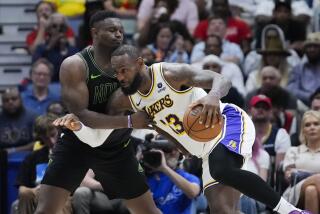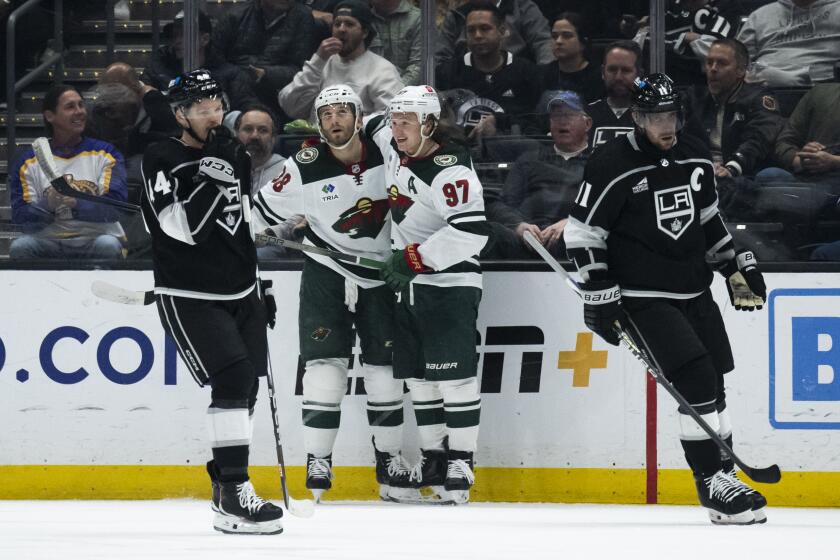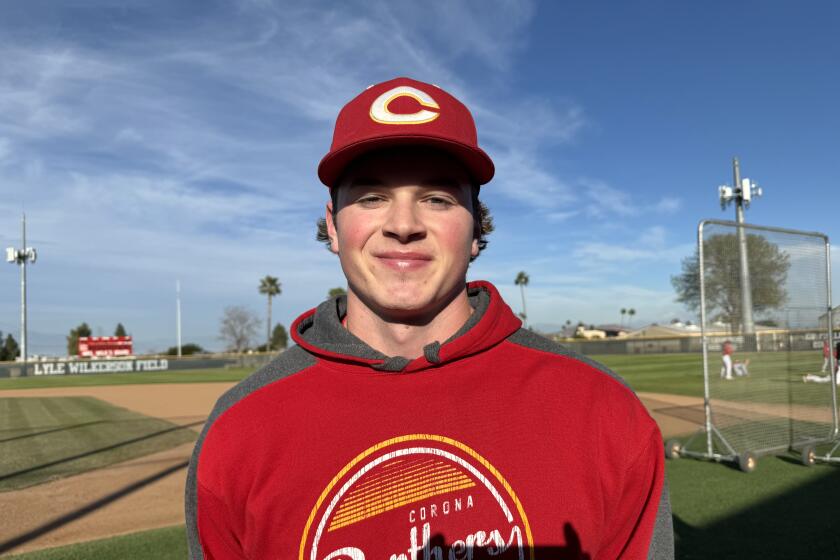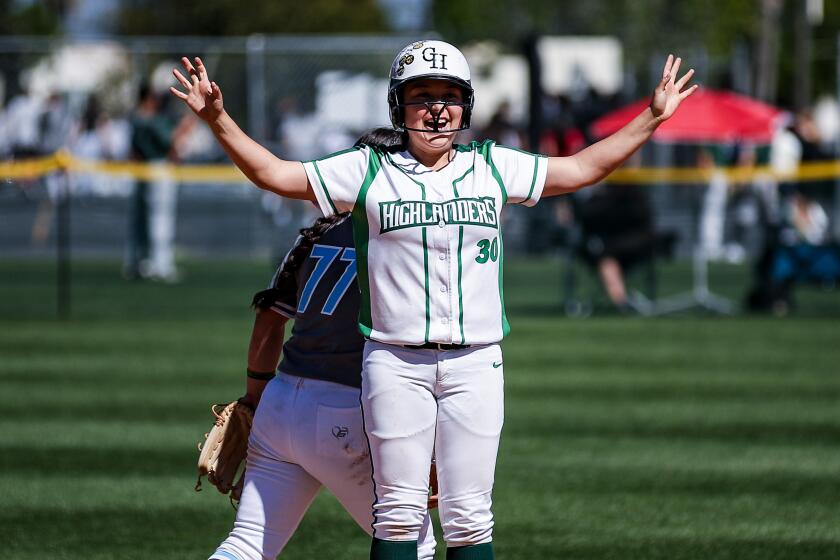His world at full tilt
Step off the elevator and into Juan Pablo Montoya’s plush penthouse suite and the first thing you notice is the breathtaking view of Miami’s Biscayne Bay beyond the floor-to-ceiling windows.
The view is so spectacular that if you look to the south -- there, beyond the horizon -- you can almost see to Colombia, where Montoya’s father began teaching him to drive race cars about the same time he was teaching him to read.
But Montoya isn’t the only one looking south from Florida these days. The hierarchy at NASCAR, which had an off year in 2006 after a decade of phenomenal growth, is also looking to Latin America -- and elsewhere -- in an effort to get stock car growth back up to speed.
All of which makes Montoya’s decision to leave open-wheel racing to join Chip Ganassi’s Nextel Cup team full time this season something of a godsend.
“Montoya choosing to run in the Nextel Cup series gives us a great moment to revel in, quite frankly,” says NASCAR President Mike Helton. “The opportunities for us, they transcend borders. They’re huge.”
And timely. NASCAR kicks off its 2007 Nextel Cup season with Sunday’s Daytona 500 after a year in which TV ratings rose for only three of the series’ 36 races, dropping 6.5% overall on Fox, 5% on TNT and a whopping 10% on NBC. And although NASCAR tracks don’t release firm attendance figures, fewer than half of last year’s races sold out, and crowds for at least 12 races decreased.
No driver, even one with Montoya’s sizable gifts, can turn that around alone. But the Colombian gives NASCAR a lot to work with.
First, there’s his skill. The youngest driver to win a championship in the old CART series, and a winner of the Indianapolis 500 and the Grand Prix of Monaco, Montoya was an open-wheel superstar. And though drivers and fans in the wine-and-brie world of Formula One tend to look down their noses at stock cars, Montoya’s defection seems likely to persuade at least some in the fractured world of open-wheel racing -- where CART’s successor, the Champ Car World Series, and the Indy Racing League battle for sponsorships and fans -- to give NASCAR a look.
Then there’s his personality. A handsome, charismatic 31-year-old, Montoya is bright and articulate in two languages -- something that will not only help NASCAR internationally but nationally as well, since more than a quarter of this year’s Nextel Cup races will be run in Texas, California, Arizona and Florida, states with sizable Latino populations.
“Once the Spanish[-speaking] community can get to know this kid is out there, he’s going to attract a whole new wave of clients,” says Felix Sabates, co-owner of the Ganassi team. “He’s a sponsor’s dream.”
He’s also wealthy and something of a celebrity on two continents -- Europe and South America. In Colombia, for instance, kids don miniature versions of Montoya’s fire suit on Halloween and he can’t go out to dinner without being hounded by fans. (Which isn’t entirely a bad thing. He met his wife Connie when she approached him for an autograph, and the couple now has two children.)
As a result, there’s an air of both erudition and regality about Montoya, who has filled his 44th-floor bayside penthouse with works by Brazilian pop artist Romero Britto and who counts Mexican royalty -- singers Luis Miguel and Patty Manterola -- among his neighbors.
“He’s bringing a whole new wave of people to the sport,” Sabates says. “He’s bringing flamboyance into the sport.”
How many other NASCAR drivers spent Super Bowl Sunday on their 86-foot Italian yachts, 40 miles out to sea? (“There was nobody else out there,” Montoya says with wonder.) Or more to the point for NASCAR, how many other drivers have websites on which 40% of the traffic comes from outside the U.S. -- not to mention the profiles in the Indian press or the fan website in Russia, www.montoya.ru?
“It’s crazy,” says Montoya, whose website has received hits from more than 100 countries. “I think it’s because I’m different. I’m willing to try anything. I’m willing to go for anything. I think people appreciate that.”
But the Cuban-born Sabates has seen another, less serious side of Montoya. He said the two often joke in Spanish -- still very much a foreign language in NASCAR garages -- sometimes making light of someone standing right next to them.
“He’s very playful,” Sabates says. “He’s a jokester, really. Most of the Formula One guys, the ones I’ve met, are prima donnas. He’s not that at all.”
Despite his hero status at home, Montoya had a privileged childhood that was different from many in Colombia, where half the population lives in poverty. His father Pablo, a successful architect, designed and built the family’s spacious A-frame house in a wooded area on the northern outskirts of Bogota, not far from the shantytowns that ring the capital.
A successful kart racer in his youth, Pablo also inspired his son’s racing career, putting the boy behind the wheel for the first time when he was 5.
By his senior year in high school, Montoya was spending four days a week studying in Bogota and three days racing in the U.S., eventually graduating to full-time racing in England and later Austria. Although he won a lot of poles, he didn’t win much money and by the end of 1996 was using roller skates to get around because he couldn’t afford public transportation.
A chance call to drive in the Formula 3000 series a year later turned things around. Montoya finished second in the season standings, which led to an invitation to test for Frank Williams’ Formula One team and, eventually, to race for Ganassi in CART. Montoya won the championship in his rookie season, becoming, at 24, the youngest CART champion in history.
Over the next eight years, Montoya competed in open-wheel races on the CART, IRL and Formula One circuits, winning in all of them before another chance phone call last summer, this one to Ganassi, reunited him with his former boss.
“I just called to say hi,” says Montoya, whose Formula One future was in doubt after he’d failed to finish in five of his 10 starts. “He told me, ‘I’m looking for a driver.’ I said, ‘Really funny. I’m looking for a drive.’ Because I was. I didn’t call him for a drive, but I was looking to decide where I was going to go in Formula One.”
He wound up racing four times in NASCAR’s second-tier Busch series last fall, finishing as high as 11th, before his first Nextel Cup start in the season-ending race at Homestead-Miami. There, he was making a run through the pack when he was spun into the wall by Ryan Newman 17 laps from the finish.
Despite the encouraging debut, and even though he was fourth-fastest in front-row qualifying for the Daytona 500 last Sunday, both Montoya and his Dodge team concede that this year will be a learning process.
Montoya got a sour taste of superspeedway racing Thursday, when a broken wheel hub threw his car into the wall during the second of two qualifying heats for Sunday’s race. That means Montoya will be starting far back, 36th, in the 43-car field.
“There’s going to be good weekends and there’s going to be bad weekends,” Ganassi said. “But all in all, what I expect out of him is to just give me 110%. If he does that, the results will be there sooner or later.”
Montoya is hardly the first to make the switch from open wheel to stock cars. A couple of generations ago, Mario Andretti and A.J. Foyt successfully drove both types of cars, each winning both the Indianapolis and Daytona 500s. And current Nextel Cup drivers Robby Gordon and Tony Stewart both came to NASCAR with Indy car pedigrees.
Montoya, however, is the first to jump from the lightly trafficked road courses of Formula One to the side-by-side oval racing of NASCAR.
“It takes a lot of confidence and it’s a huge amount of pressure to say that I’m leaving F1 and go over to NASCAR,” four-time Cup champion Jeff Gordon said at last week’s NASCAR media day. “You’ve got to give him credit for that, which is why he’s been accepted so well.”
But, Gordon added, with a laugh, goodwill has its limits.
“Once he starts winning, that’s all going to change,” he said.
The challenge for Montoya is to carry last fall’s momentum into this season, something he got a good start on when he teamed with Scott Pruett and Salvador Duran to win last month’s Rolex 24-hour endurance sports car race at Daytona, joining Andretti as the only drivers to win the Indy 500, a CART title, a Formula One race and North America’s most important sports car race.
And with a victory Sunday at Daytona Beach, Montoya would, at least in one regard, better Andretti, who won the Formula One championship in 1978 but has never won the Grand Prix of Monaco.
Montoya, who won at Monte Carlo in 2003, would then be the only man to have won the signature events in NASCAR, the Daytona 500; Formula One, the GP of Monaco; and Indy cars, the Indianapolis 500.
“That,” Ganassi says, “is a tall order.”
*
*
Begin text of infobox
New road
PERSONAL STATISTICS
Birth date: Sept. 20, 1975
Birthplace: Bogota, Colombia
Residence: Miami.
CAREER HIGHLIGHTS
1999 CART champion
2000 Indianapolis 500 winner
2003 Monaco Grand Prix winner
Youngest CART champion in series history
NASCAR
* On July 9, 2006, Montoya announced his plans to compete in the Nextel Cup series beginning with the 2007 season, racing for Chip Ganassi Racing in the No. 42 Texaco/Havoline Dodge. Deal wasn’t finalized until September, relieving Montoya of his open-wheel contract.
* On Nov. 19, 2006, Montoya competed in his first career Nextel Cup race, the Ford 400 at Homestead-Miami Speedway He qualified 29th in the No. 30 Texaco Dodge. On Lap 251, Montoya’s car hit the wall and caught fire, taking him out of the race. He was unharmed, and was credited with a 34th-place finish.
* Starting Sunday’s race in the 36th position.
*
Sources: jpmontoya.com and NASCAR
Los Angeles Times
More to Read
Get our high school sports newsletter
Prep Rally is devoted to the SoCal high school sports experience, bringing you scores, stories and a behind-the-scenes look at what makes prep sports so popular.
You may occasionally receive promotional content from the Los Angeles Times.







